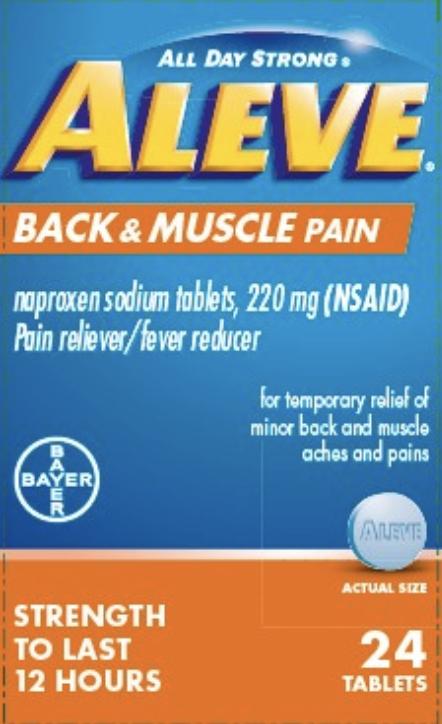Aleve Back and Muscle Pain Interactions
There are 474 drugs known to interact with Aleve Back and Muscle Pain (naproxen), along with 11 disease interactions, and 4 alcohol/food interactions. Of the total drug interactions, 101 are major, 346 are moderate, and 27 are minor.
- View all 474 medications that may interact with Aleve Back and Muscle Pain
- View Aleve Back and Muscle Pain alcohol/food interactions (4)
- View Aleve Back and Muscle Pain disease interactions (11)
Most frequently checked interactions
View interaction reports for Aleve Back and Muscle Pain (naproxen) and the medicines listed below.
- acetaminophen
- albuterol
- amlodipine
- atorvastatin
- Benadryl (diphenhydramine)
- bupropion
- cyclobenzaprine
- famotidine
- Fish Oil (omega-3 polyunsaturated fatty acids)
- Flonase (fluticasone nasal)
- gabapentin
- ibuprofen
- levothyroxine
- lisinopril
- losartan
- magnesium glycinate
- magnesium oxide
- melatonin
- meloxicam
- metformin
- omeprazole
- pantoprazole
- prednisone
- rosuvastatin
- tizanidine
- trazodone
- Vitamin B12 (cyanocobalamin)
- Vitamin C (ascorbic acid)
- Vitamin D3 (cholecalciferol)
- Zyrtec (cetirizine)
Aleve Back and Muscle Pain alcohol/food interactions
There are 4 alcohol/food interactions with Aleve Back and Muscle Pain (naproxen).
Aleve Back and Muscle Pain disease interactions
There are 11 disease interactions with Aleve Back and Muscle Pain (naproxen) which include:
- asthma
- fluid retention
- GI toxicity
- rash
- renal toxicities
- thrombosis
- sodium
- anemia
- hepatotoxicity
- hyperkalemia
- platelet aggregation inhibition
More about Aleve Back and Muscle Pain (naproxen)
- Aleve Back and Muscle Pain consumer information
- Compare alternatives
- Drug images
- Latest FDA alerts (8)
- Side effects
- Dosage information
- During pregnancy
- Drug class: Nonsteroidal anti-inflammatory drugs
- Breastfeeding
Related treatment guides
Drug Interaction Classification
| Highly clinically significant. Avoid combinations; the risk of the interaction outweighs the benefit. | |
| Moderately clinically significant. Usually avoid combinations; use it only under special circumstances. | |
| Minimally clinically significant. Minimize risk; assess risk and consider an alternative drug, take steps to circumvent the interaction risk and/or institute a monitoring plan. | |
| No interaction information available. |
See also:
Further information
Always consult your healthcare provider to ensure the information displayed on this page applies to your personal circumstances.


